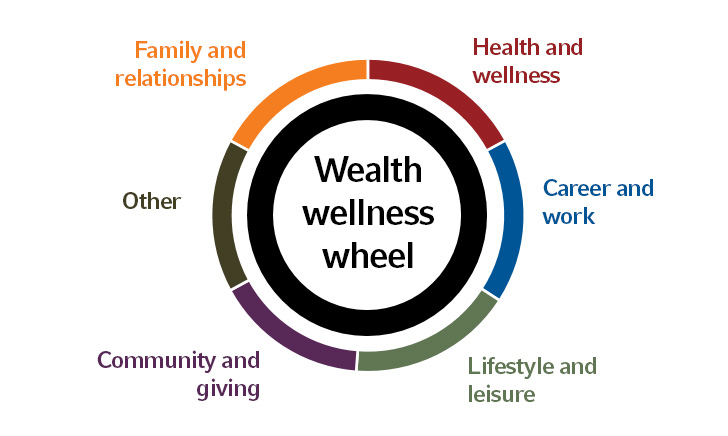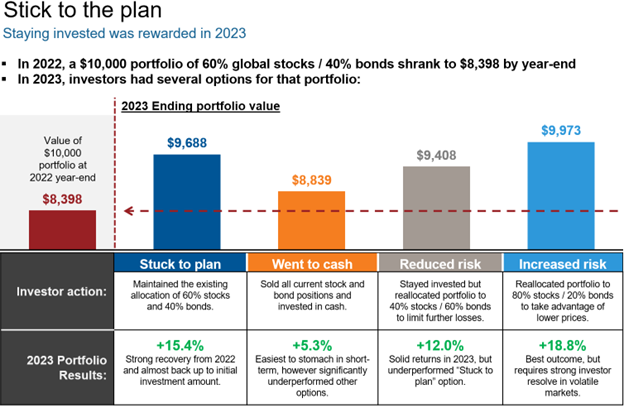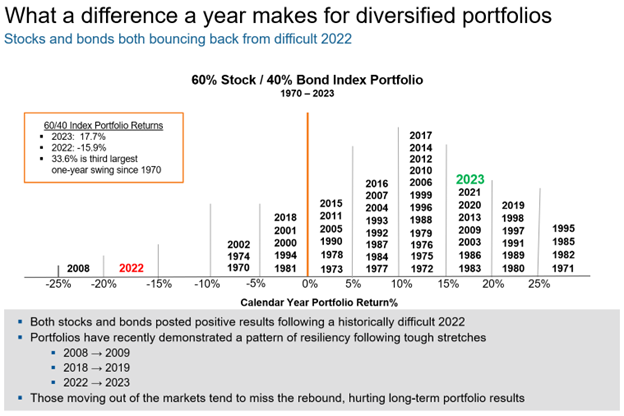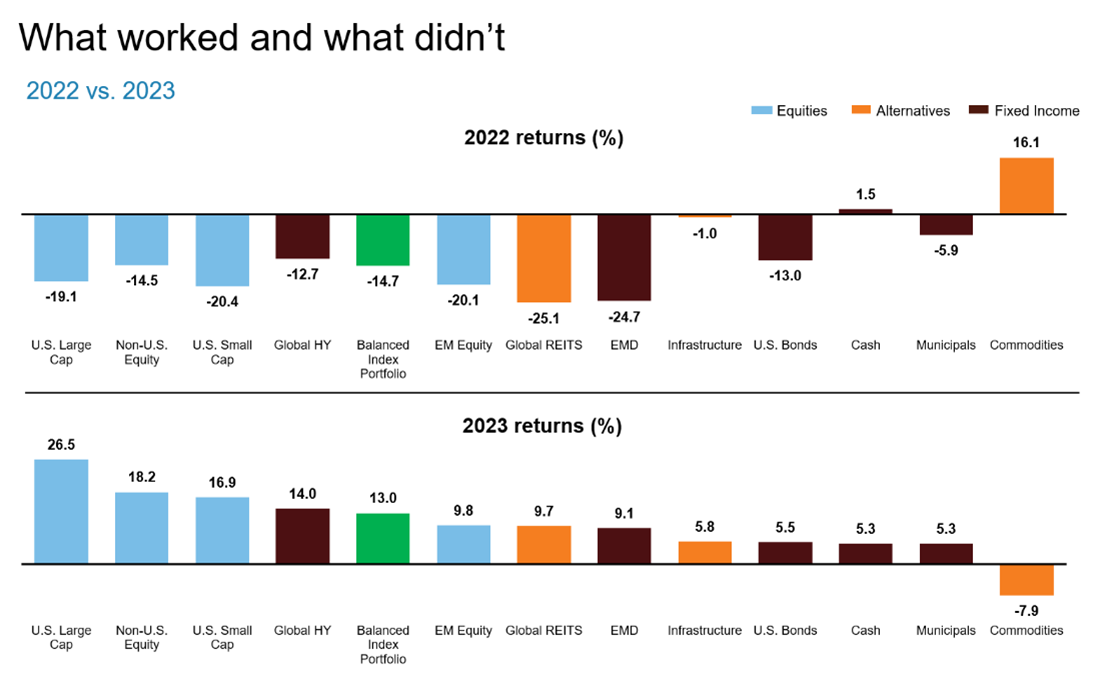Mastering 2024: A financial advisor's guide to starting the year strong
Executive summary:
- Financial advisors are gearing up for a successful year and preparing for client reviews.
- We offer four actionable ideas and practices to help advisors address some key concerns many investors are having about the year ahead.
- We believe financial advisors who understand client concerns, embrace rediscovery, and foster meaningful relationships have the potential to grow their practices in the year ahead.
As we usher in 2024, financial advisors are gearing up to set the tone for a successful year. Many of you are thinking about client reviews and the issues clients may talk about in those meetings. Here we share four actionable ideas and practices to empower those conversations while addressing some key concerns many investors are having about the year ahead.
1. Understanding client concerns through rediscovery
Being aware of the concerns topping clients' minds is a place to start for many financial advisors. During one of our webinars in early January, we conducted a poll with 165 advisors. This revealed that key client concerns for 2024 include the decision about where to invest excess cash now and the potential threat of a recession.
Rediscovering client priorities. In a rapidly evolving landscape, rediscovering client priorities becomes paramount. More than ever, we believe advisors should initiate a rediscovery process. Understanding clients' shifting priorities and personalization needs is essential for building trust. We have an interactive discovery process that focuses on five key areas of life that have financial implications. The wealth wellness wheel provides a structured exercise to help advisors identify and prioritize clients' top three concerns. A review meeting can be a great time to ask, how are you feeling about these buckets right now? This not only opens the door for discussion but also provides a segue to revisit the initial purpose of the financial plan—and whether it needs to be revised due to renewed market turbulence, with foresight into potential challenges.
Navigating investment decisions: A visual approach
Every quarter, Russell Investments crafts an Economic & Market Review slide deck, accompanied by supplementary videos. This comprehensive package is tailored to be client-ready, providing investors with insightful context on the factors steering both the economy and the markets.
To address worries about investing sidelined cash and concerns about a looming recession, we suggest using visuals to enhance client understanding. Charts and insights can make those discussions compelling. Here's one chart from our latest presentation we feel is worth sharing. It visually analyses the performance of a balanced portfolio consisting of 60% stocks and 40% bonds over more than 50 years, showcasing the resilience of a diversified approach.
Index portfolio of 60% S&P 500 Index and 40% Bloomberg U.S. Aggregate Bond Index. Index returns represent past performance, are not a guarantee of future performance, and are not indicative of any specific investment. Indexes are unmanaged and cannot be invested in directly.
Lessons from 2022 and 2023:
Taking a closer look at specific asset classes in the challenging year of 2022 and the subsequent recovery in 2023 reinforces the importance of a diversified portfolio. The chart below presents the two years as nearly mirror images. How does this relate to your client's portfolio? Picture stocks as the accelerator, bonds as the brakes, and commodities as airbags--each playing a distinct role in steering and safeguarding the overall portfolio. As their trusted advisor, you can help guide clients towards a portfolio that is prepared to weather different scenarios. The chart below also helps set the stage for discussions with clients who currently hold cash, encouraging consideration of transitioning into other asset classes before interest rates move downward.
Click image to enlarge
Source: U.S. Small Cap: Russell 2000® Index; U.S. Large Cap: Russell 1000® Index; Global: MSCI World Net Index; Non-U.S.: MSCI EAFE Net index; Infrastructure: S&P Global Infrastructure Index; Global High Yield: Bloomberg Global High Yield Index; Global REITs: FTSE EPRA/NAREIT Developed Index; Municipals: Bloomberg Municipal Index, Cash: FTSE Treasury Bill 3 Month Index; EM Equity: MSCI Emerging Markets Index; U.S. Bonds: Bloomberg U.S. Aggregate Bond Index; EMD: Bloomberg EM USD Agg Bond Index; Commodities: Bloomberg Commodity Index Total Return; Balanced Index: 5% U.S. Small Cap,15% U.S. Large Cap, 10% Global, 12% Non-U.S., 4% Infrastructure, 5% Global High Yield, 4% Global REITs, 0% Cash, 6% EM Equity, 30% U.S. Bonds, 5% EMD and 4% Commodities. Index returns represent past performance, are not a guarantee of future performance, and are not indicative of any specific investment. Indexes are unmanaged and cannot be invested in directly.
3.Track your value-adds: Showcasing an advisor's value
If your client is socking away money for a goal that's way off in the future, how do you showcase the value you've brought in the short term? The temptation might be to zoom in on recent performance benchmarks, but we think that kind of short-term focus can throw a long-term strategy off course.
Instead, take a look at the concrete, meaningful milestones you've achieved for your specific client in the past 12 months. Maybe you set up a trust for them or made sure their estate plan covered all their investment holdings. Did you clarify beneficiaries for their IRA, or help them reach a charitable giving milestone? Perhaps you coached them to increase their contributions to retirement savings or helped them save on taxes.
To help articulate the value of your conversation, consider using our client engagement roadmap. This tool not only illustrates the next steps and shared commitments but also provides structure to your meeting schedule—an essential element supporting your communication strategy and continuous service model.
Highlighting the value of financial advisors in challenging markets, the chart below delves into the impact of different investment decisions in 2023. Opting to stay invested or adjusting risk levels proved rewarding, starkly contrasting with the missed opportunity by moving to cash. This underscores the pivotal role advisors play in guiding clients through uncertain times.
Click image to enlarge

Source: Morningstar. Stocks represented by MSCI ACWI Index, bonds represented by Bloomberg U.S. Aggregate Bond Index and cash represented by FTSE 3 Month T-Bill Index. Index returns represent past performance, are not a guarantee of future performance, and are not indicative of any specific investment.
4. Building stronger relationships with Centers of Influence
Center of Influence (COI) relationships often start with positive intentions, shared goals, and discussions about mutual interests. However, it takes more than just an initial conversation to cultivate a reciprocal COI relationship. Even if a COI has numerous clients who could benefit from your services, lacking a personal connection may hinder their likelihood of thinking of you.
Effectively articulating your value is essential. COIs must understand what you do and how you can assist their clients. Advisors sometimes skip this step, assuming professionals grasp the value they bring. However, it's your responsibility to train them on your unique value proposition and why you're the optimal choice for their clients.
When building COI relationships, consider best practices. Many advisors excel at client discovery and relationship building but struggle when it comes to COIs. However, the principles that work with clients often apply to COIs. Consider implementing a service model for COI relationships. Regular contact is key, with expectations set for referral sharing and meeting frequency. Strike a balance between educational meetings to convey your value, social interactions to nurture relationships, and client events to enhance their understanding of your business. Additionally, establish a reporting system for proper follow-up on all received referrals.
In the pursuit of growth, we encourage advisors to select three to five COIs, engage in intentional conversations, and utilize key questions to deepen relationships. A commitment to continuous improvement and collaboration can help drive referrals and foster business growth. For additional guidance, Russell Investments has a comprehensive COI guide available through your regional team.
Conclusion: your strong start to 2024
As we embark on this new year, the key to success lies in understanding client concerns, embracing rediscovery, and fostering meaningful relationships Advisors wield the ability to steer through uncertain markets, add value to clients' lives, and shape 2024 into a year for potential growth. We stand ready to assist you in realizing your objectives. Employing the four actions outlined can help you reach your full potential. Let's talk about how we can help. Here's to a strong 2024.

